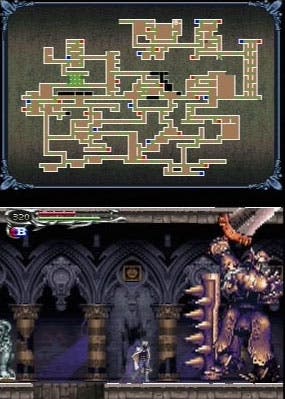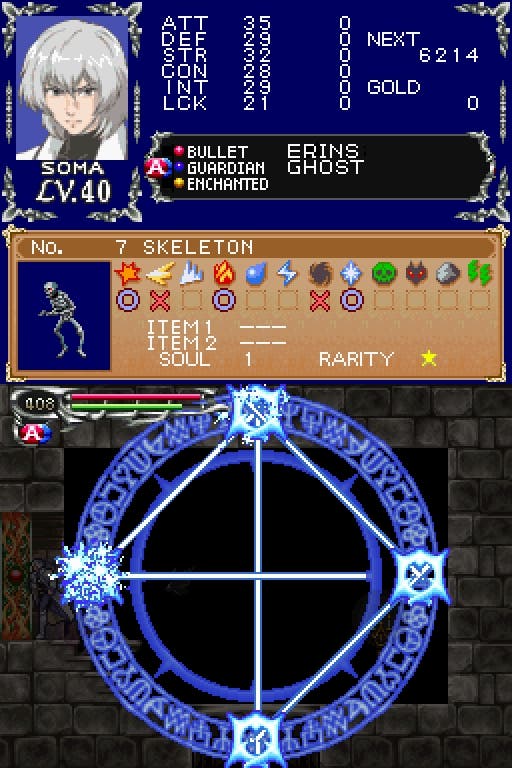Castlevania: Dawn of Sorrow
Invite it in.
Being heir-apparent to Dracula sounds fun. You can absorb souls and inherit their powers, you get a big castle, and immensely hot women with no relationship sense will gather round to comfort you and prevent you slipping completely into evil. Even if you did, they'd probably still gather round. Why, then, is Soma Cruz, Dracula's actual heir, so very depressed about it?
Well, for one thing, people keep trying to kill him. In fact, that's the main thing. Last time it was the goodies, who didn't really trust him not to go all the way bad, and now, in Dawn of Sorrow - set at the point in the Castlevania timeline when Dracula's castle is set to reassume some of its former power - it's a bunch of cultists who, while they actually believe in God, equally believe that for him/it/she/Yahweh/etc. to exist there must be an opposing being of absolute evil. Namely Dracula. Since they have some candidates to replace Soma and be the dark lord, they're keen to do away with him.
All of which draws us back, AGAIN, to Dracula's castle, where nasty things are unfolding thanks to the cultists and, well, the fact that it's Dracula's castle. Not that we're complaining - Dawn of Sorrow is one of the best Castlevania games we can remember, and although its concessions to the DS's unique feature-set are of varying quality and import, it's still a game that you definitely need to own if you have more than a passing interest in action-adventure. Although, you might want to clarify whether it's action-adventure you like, first, because Castlevania's biggest trick was and is its unique transcendence of gaming instincts.
The most obvious things to say about Dawn of Sorrow are things we've heard before. It's a 2d, side-scrolling game that subtly blends combat and platforms into a puzzle mix. As Soma Cruz, you do much as the Belmonts used to, feeling out the boundaries of the areas you can reach and then using your various abilities to make progress in one of them, maybe meeting a boss, and through your actions being granted access to some tool or ability that you didn't have, which makes critical difference in another area. Or several.
In this way you make progress through the castle, using the 2d map to monitor your progress and handy warp points to shorten the distance when it's necessary to backtrack, and as you do you build up an arsenal of weapons and abilities, each with specific characteristics - axes may do more damage over a wider area, for example, but they lack speed compared to daggers - and with demons of many descriptions lurking in every room, respawning when you re-enter, you're going to need to get used to those characteristics.

As Dracula's heir, your ability to consume souls gives you command of an unusual repertoire of moves, which can be equipped like weapons or armour. Some are passive, simply improving a particular characteristic, while others are more active, allowing you to float as you drop through the air rather than tumbling directly, for example, or chucking a puppet through a small gap and then switching places with it. More still are simply violent - big bows and arrows, laser beams and such - which drain your mental strength bar.
As you go, you continually top yourself up with health and strength potions and new weapons from Hammer, the shop-keep. At least, you do when you pop back over to see him, as he's not one of these nutty 'keepers who tends to spring up everywhere. His opposite number is a blonde witch called Yoko, whose main virtue - assuming you find her conversational skills inversely proportional to the contents of her [cauldron - Ed] - is forging your weapons into bigger, more impressive vessels of DEATH using some of your gathered souls.
This being the DS, Dawn of Sorrow also benefits from the second screen, stylus and wireless networking - with varying degrees of success. Best use, oddly, is the most basic - constantly displaying the 2D map on the top-screen may be simple, but it removes a frustrating layer of interface that used to chew up our goldfish-brained will to live, never mind all the time it took us to check on it every few seconds. When you do dive into the menus, they're split over both screens allowing you to take more in at once.

Wi-Fi, to get that out of the way, is two modes - VS Mode and Soul Trade. The former involves getting friends to battle through levels populated, to your specification, with enemies. The latter is for trading souls, ergo abilities. And if you think we've tried either, then you also think we got sent two copies. We didn't. Neither sounds that essential though. Trading souls in particular sounds like it flies in the face of the way the single-player works. Although we suppose that's what bats do.
Stylus use is a touch haphazard. Using it to carve a path and even staircases out of icy blocks is a neat trick, but its main use here is for drawing Magic Seals, the final act of most boss fights. Basically, when you land the decisive blow against one of the big'uns, a circular interface pops up and you have to draw a specific pattern between blue flaming points dotted around it. This is fine at first, but it gets a bit awkward and it feels bolted on - although we certainly appreciated the sight of it when we'd been busily thwacking a particular enemy with no joy for some time.
As you can probably infer from all of that - and as you doubtless understand if you're any kind of Castlevania follower - repetition, replay and backtracking are inherent to the series and Dawn of Sorrow. Although there's a network of warp points, they're not always quickly uncovered, so journeying back and forward on foot is to some extent inevitable. Indeed, the design tends toward backtracking, because it's about keeping an eye open for new openings and then remembering to exploit them later.

There's nothing particularly wrong with this approach, and thanks to an RPG-style progression system of levelling up health, strength, defence and other attributes, as well as the near-constant acquisition of new weapons and abilities, you'll find that areas become easier to traverse. An enemy that breathes a poisonous cloud after being clubbed three times, taking four blows to die, may be gone in one strike of your best weapon just a couple of hours later, virtually nullifying the threat. You also acquire the ability to switch between "sets" of abilities and weapons/armour by tapping X, which speeds things up.
That said, Dawn of Sorrow - as much as any of its forebears - relies to a certain extent upon the player's willingness to be engaged in this practice of pushing and pulling in familiar areas. Exploring a new area becomes a balancing act - do you keep pushing forward, because a save point's probably going to pop up soon, or double-back before the return journey becomes too perilous to complete without dying? Dawn of Sorrow is sometimes exacting in this sense, but it's usually just the right side of fiendish.
As are the bosses. Some are about brute strength and learning attack patterns; others require a more thoughtful approach. Not all are memorable, but they break things up, save points are always nearby, and the sense of satisfaction you get from conquering one is worthwhile - and the inevitable new toy a sort of blood-soaked cherry on top.
Dawn of Sorrow, like its predecessors and the Metroid series to some extent, is one of those games that initially seems to contradict accepted wisdom about mechanics becoming tedious when you can see through them, because while on the surface it's about roaming round a castle collecting weapons and triumphing over evil, that's not what its hooks are snagging you with. At one point, you're faced with a sliding puzzle that controls the rooms - this is far more of a microcosm for whole game. It's not that it relies on a healthy suspension of disbelief to overcome its contrived elements; it's about bringing order to foggy chaos. This, it does with aplomb.
And then it's about doing the whole thing again with another character. Seriously. Buy a stake.








